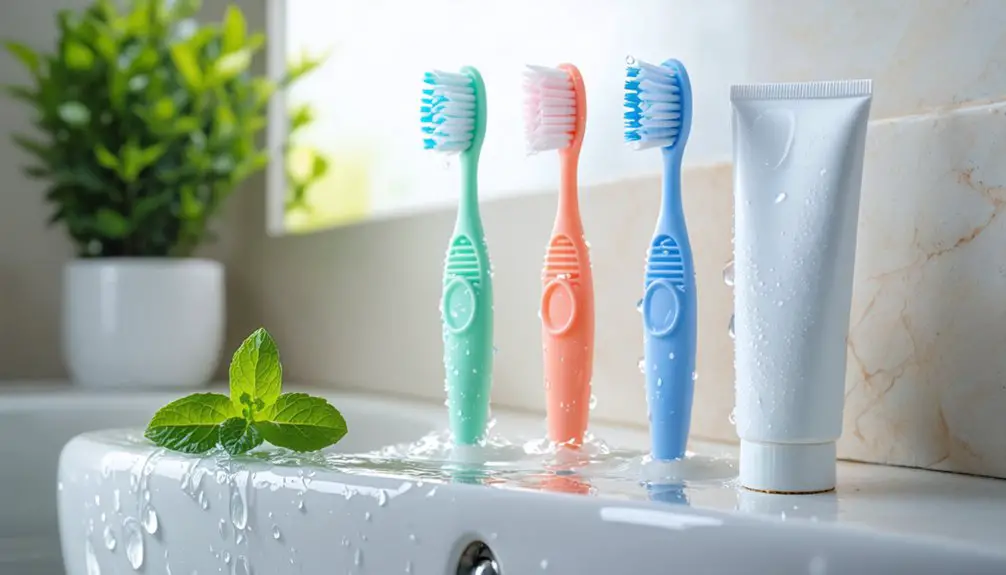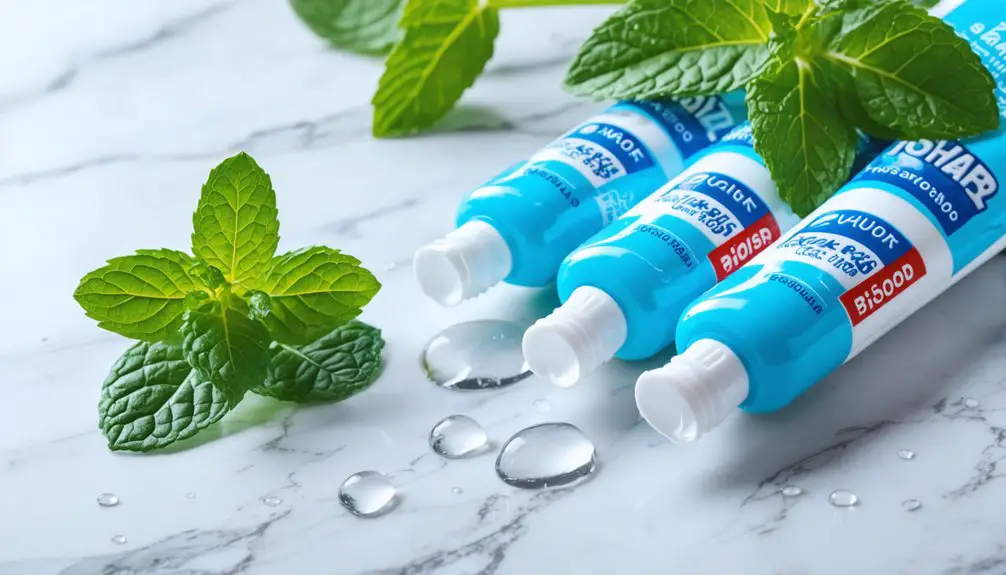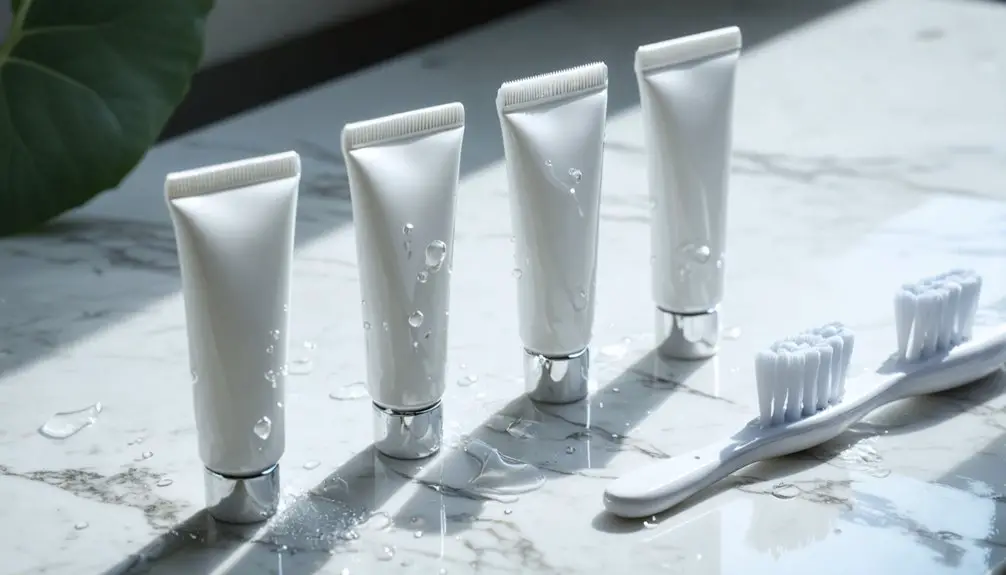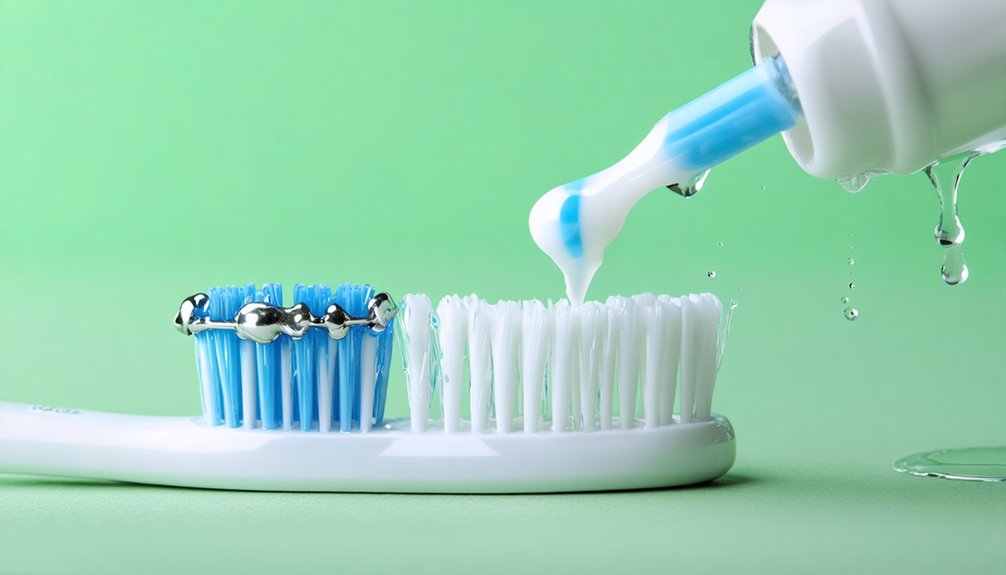To enhance your smile, select toothpaste with proven ingredients like fluoride compounds (1,500 ppm) for cavity protection and gentle abrasives for stain removal. Look for the ADA Seal of Acceptance to guarantee clinical testing standards. Combine sensitivity-relief ingredients like potassium nitrate with remineralizing agents, and wait 30 minutes after brushing before rinsing to maximize effectiveness. Understanding the science behind toothpaste ingredients will help you make informed choices for peak oral health.
Key Takeaways
- Choose toothpaste with both fluoride compounds and remineralizing agents to strengthen enamel and protect against cavities effectively.
- Look for the ADA Seal of Acceptance to ensure your toothpaste meets rigorous clinical testing standards for safety and effectiveness.
- Wait 30 minutes after brushing before rinsing to allow active ingredients maximum time to work on your teeth.
- Select whitening toothpaste with hydrogen peroxide or blue covarine to safely remove surface stains and enhance smile appearance.
- Combine toothpaste with complementary products like enamel serums for enhanced protection and better overall smile results.
Understanding Essential Toothpaste Ingredients
Modern toothpaste formulations rely on a sophisticated blend of active ingredients that work synergistically to protect your oral health. At the core, fluoride compounds like sodium fluoride and stannous fluoride strengthen your enamel and fight cavities at concentrations of 1,500 parts per million. Adding saccharin as sweetener helps improve the overall taste experience while maintaining effectiveness.
Advanced toothpaste science combines targeted ingredients that protect dental health, with fluoride compounds as the cornerstone for strong, cavity-resistant enamel.
To achieve ideal toothpaste consistency, manufacturers incorporate humectants like sorbitol and glycerin, while binders such as carboxymethyl cellulose provide stability. For those seeking alternative options, toothpaste containing plant-based extracts offers a natural approach to oral care.
Gentle abrasives including calcium carbonate and silica help remove surface stains, while sodium lauryl sulfate creates the foaming action that spreads the active ingredients.
Whether you’re choosing natural options with essential oils or traditional formulations, consider your flavor preferences – from classic peppermint to alternatives like cinnamon bark oil. Each ingredient serves a specific purpose in maintaining your dental health.
The Science Behind Enamel Remineralization
Your tooth enamel naturally loses minerals throughout the day when acids from bacteria and foods drop the pH below 5.5, creating microscopic voids in the crystalline structure.
Your saliva contains calcium and phosphate ions that can naturally flow back into these voids to repair and strengthen the weakened enamel structure. Fluoride compounds help form fluorapatite crystals that are more resistant to acid than natural enamel. This process can take up to two hours for saliva to neutralize the acids produced by plaque bacteria.
When you notice white spots on your teeth, it’s often a sign of mineral loss that can still be reversed through proper remineralization before a cavity forms.
Understanding Mineral Loss Patterns
The complex process of tooth enamel demineralization begins at the surface level, where acid attacks from bacteria and dietary sources dissolve the hydroxyapatite crystals that form your teeth’s protective layer.
You’ll first notice white spot lesions, which indicate your enamel’s becoming porous and chalky – a critical warning sign of mineral loss.
Understanding enamel demineralization causes is essential: the loss primarily occurs along prism boundaries, progressing from the outer surface inward.
Modern research shows that incorporating nano-chitosan treatments can help rebuild and strengthen demineralized enamel surfaces.
As calcium and phosphate ions are stripped away, your enamel becomes rougher and more permeable.
This wear pattern tends to worsen with age, affecting 3% to 17% of adults between ages 20 and 70.
Enzymatic activity, particularly matrix metalloproteinases, further compromises enamel integrity by breaking down supporting organic matrices.
To prevent mineral loss, you’ll need to maintain proper oral pH and protect against these acid attacks through consistent oral hygiene practices.
Natural Repair Process Explained
While damaged tooth enamel can’t regrow or regenerate naturally, your teeth possess an impressive ability to repair themselves through remineralization – a process where calcium, phosphate, and fluoride ions rebuild weakened enamel crystal structures.
The remineralization mechanisms work through several sophisticated pathways. When fluoride ions replace hydroxyl components in your enamel’s hydroxyapatite structure, they form stronger fluorapatite crystals that better resist acid attacks. Salivary enzymes help neutralize harmful bacterial acids that could impede this healing process.
Your saliva delivers essential minerals to demineralized areas, while specialized proteins create protective nanofilms that serve as scaffolds for new crystal growth.
Understanding these natural repair processes helps you support ideal enamel health. The key is maintaining adequate mineral availability through proper oral care while limiting acidic challenges that can overwhelm your teeth’s natural healing abilities.
Choosing the Right Sensitivity Relief Formula
Selecting an effective sensitivity relief toothpaste requires understanding how different active ingredients target tooth pain. When comparing ingredients, potassium nitrate blocks pain signals between your teeth and brain, while stannous fluoride creates a protective barrier over exposed dentin. Both address common sensitivity triggers like hot, cold, and sweet stimuli.
For thorough care, look for formulations that combine multiple active ingredients. You’ll find toothpastes with up to 5% potassium nitrate plus sodium monofluorophosphate, which both strengthens enamel and reduces sensitivity. Regular dental visits can help monitor if your chosen toothpaste effectively addresses sensitivity issues. Using a soft-bristled toothbrush helps prevent further enamel wear while applying sensitivity toothpaste.
If you prefer natural options, ingredients like aloe vera and arginine provide gentler relief through inflammation reduction and tubule sealing.
Consider consulting your dentist if sensitivity persists, as they can recommend specific formulations based on your unique triggers and symptoms.
Safe and Effective Whitening Options
Beyond addressing tooth sensitivity, many people seek effective ways to brighten their smile.
When comparing whitening toothpastes, it’s crucial to separate facts from common whitening myths. While these products can effectively remove surface stains from coffee or tobacco, they won’t change your teeth’s natural color like professional treatments can. Using high-concentration peroxide gel under professional supervision typically provides more immediate and dramatic whitening results.
For safe and noticeable results, consider these evidence-based options:
- Choose ADA-approved whitening toothpastes containing hydrogen peroxide or blue covarine.
- Use the product consistently twice daily for 2-6 weeks to see results.
- Consider professional treatments for deeper stains or faster results.
Remember that over-the-counter products work gradually through gentle surface stain removal.
If you’re helping patients achieve brighter smiles, recommend starting with whitening toothpaste before progressing to stronger treatments.
Key Safety Certifications to Look For
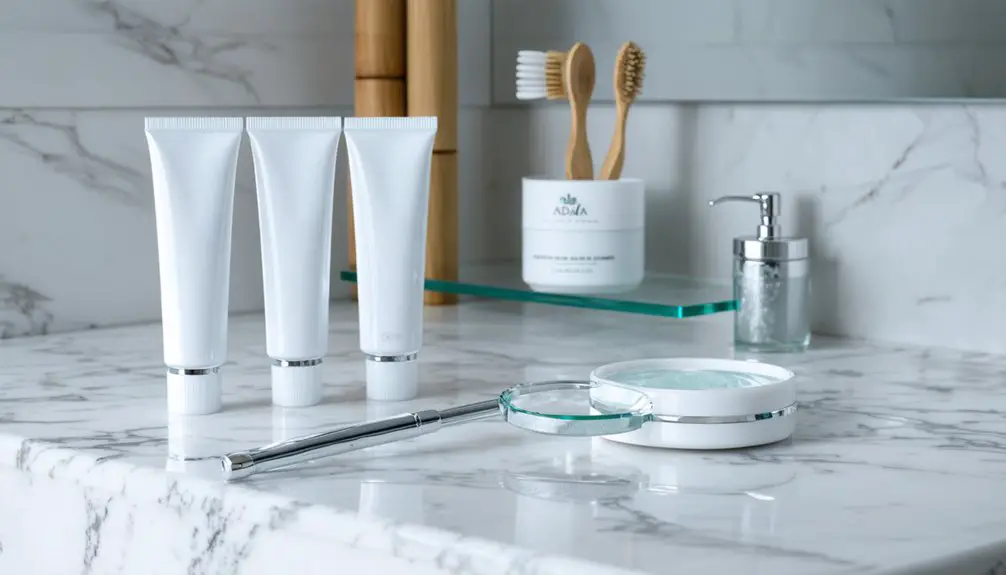
When shopping for toothpaste, you’ll need to verify key safety certifications that demonstrate a product’s efficacy and safety standards.
Look for the ADA Seal of Acceptance, which requires rigorous clinical testing and expert review to guarantee product safety and effectiveness. This certification guarantees fluoride content meets established benchmarks for cavity protection.
The Toothfriendly certification offers additional assurance, confirming products won’t contribute to tooth decay or erosion.
Products with Toothfriendly certification provide peace of mind, ensuring your toothpaste helps protect against dental decay and enamel erosion.
Pay attention to ingredient transparency on packaging, as certified products must clearly display their approval status and formulation details.
These safety certifications undergo regular re-evaluation, typically every five years, to maintain compliance with current standards.
Natural vs. Chemical Ingredients: Making the Right Choice
Today’s toothpaste market presents an essential choice between natural and chemical ingredients, each offering distinct benefits for oral health.
While natural ingredient benefits include gentler formulations for sensitive gums and eco-friendly packaging, synthetic options provide scientifically proven cavity protection through fluoride and advanced whitening capabilities.
To make an informed decision, consider these key factors:
- Your specific dental needs – natural options work well for mild concerns, while synthetic formulations target advanced issues.
- Sensitivity levels – natural ingredients tend to be gentler, offsetting synthetic ingredient drawbacks like irritation.
- Environmental impact – natural toothpastes typically offer more sustainable packaging and biodegradable ingredients.
The right choice depends on balancing your oral health requirements with personal values regarding chemical exposure and environmental responsibility.
Maximizing Your Toothpaste’s Benefits
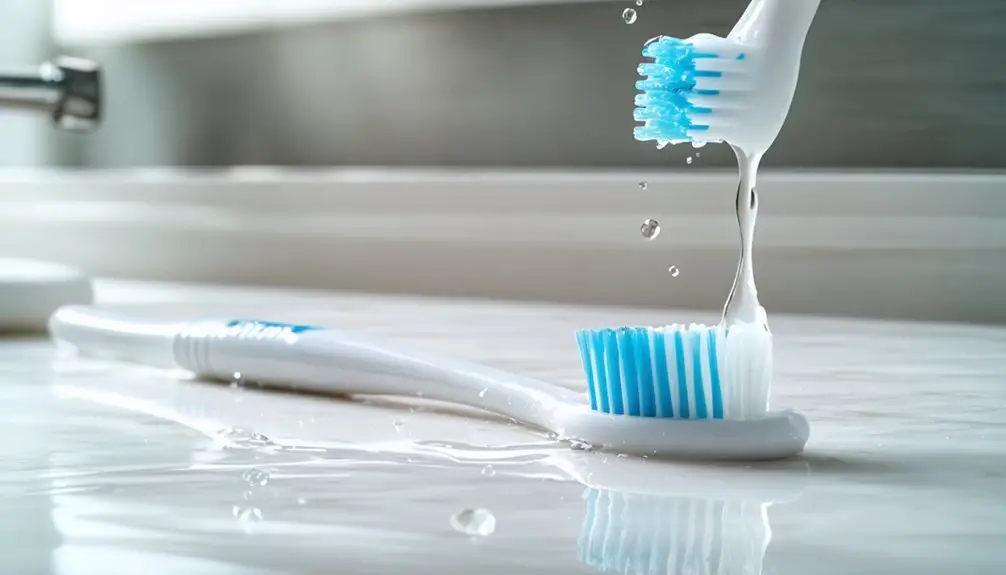
To maximize your toothpaste’s effectiveness, start by selecting products with proven combinations like calcium silicate/phosphate and fluoride that enhance remineralization.
You’ll achieve better results by implementing the Prepared Toothpaste Delivery (PTD) technique, which involves applying undiluted toothpaste to interproximal spaces before brushing at a 15-30° angle.
Consider incorporating complementary products like enamel serums alongside your toothpaste routine to boost protective effects and strengthen tooth structure.
Smart Ingredient Selection Tips
Selecting the right toothpaste ingredients can greatly impact your oral health outcomes. When evaluating toothpaste types, you’ll want to understand how different ingredients work together to protect your teeth. Key ingredient interactions, such as fluoride combined with abrasives, create ideal cleaning and protection.
- Choose fluoride formulations wisely – sodium fluoride offers proven cavity protection, while stannous fluoride provides enhanced antibacterial benefits and fights bad breath.
- Consider your specific needs – hydroxyapatite-based options work well for sensitive teeth, while natural alternatives like theobromine can support enamel strength.
- Look for balanced formulations – proper ratios of humectants and surfactants guarantee even distribution of active ingredients while maintaining pleasant texture and effective foam action.
Optimizing Brushing Technique Daily
While many people focus on choosing the right toothpaste, proper brushing technique ultimately determines how effectively those ingredients work. You’ll achieve ideal plaque removal by using the Modified Bass technique – placing bristles at a 45-degree angle to your gumline and applying gentle vibratory motions.
For maximum benefits, brush for at least two minutes twice daily using a soft-bristled toothbrush. Apply a pea-sized amount of toothpaste evenly across tooth surfaces.
Replace your toothbrush every 3-4 months or when bristles become frayed to maintain cleaning efficiency. Avoid aggressive horizontal scrubbing that can damage enamel and gums.
Remember that consistent, focused execution of proper brushing techniques matters more than rushing through your routine. Regular technique refinement with your dentist’s guidance will help enhance your oral care results.
Combining Products For Results
Understanding how to combine toothpaste ingredients and products strategically can greatly enhance your oral care routine.
Research shows remarkable toothpaste synergy when specific active ingredients work together. For example, combining nano-hydroxyapatite with fluoride creates superior enamel protection, while sodium bicarbonate paired with sodium hyaluronate delivers enhanced plaque control.
To maximize your toothpaste’s benefits:
- Choose formulations containing both fluoride and remineralizing agents like nano-hydroxyapatite for ideal cavity protection.
- Look for products that combine plaque-fighting ingredients like sodium bicarbonate with protective compounds.
- Wait 30 minutes after brushing before rinsing to allow active ingredients time to work effectively on your teeth.
These evidence-based combinations will help you achieve better oral health outcomes than using single-ingredient products alone.
Special Considerations for Family Dental Care
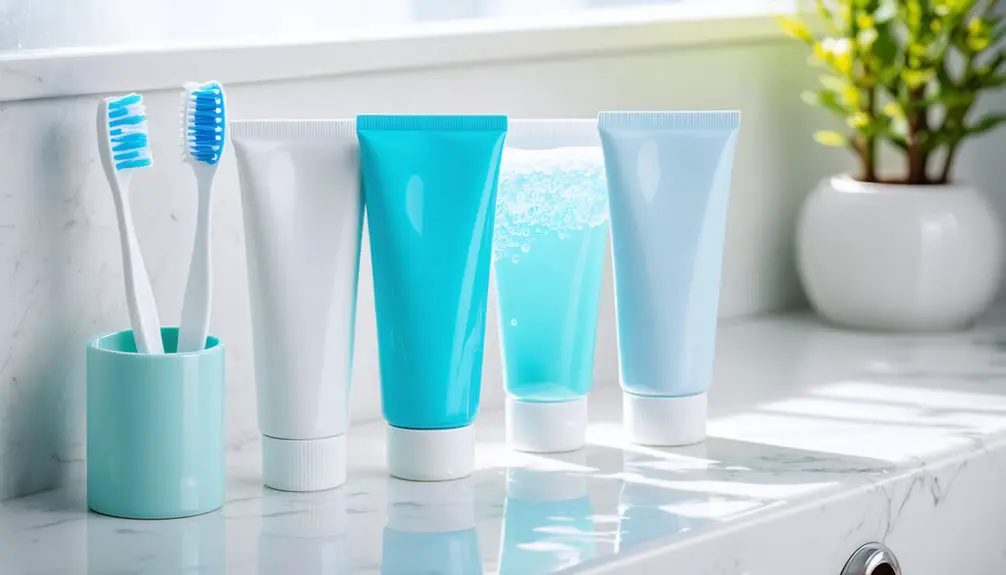
When managing dental care for an entire family, each age group requires specific attention and tailored approaches to maintain ideal oral health.
Consider that while 90% of children now have dental insurance coverage, adult utilization rates vary considerably across different family demographics. You’ll need to adapt your oral health strategies accordingly, from ensuring children visit the dentist by age 1 to addressing the unique challenges faced by adults over 65, who show a 63.7% dental visit rate.
Early dental care and consistent check-ups remain vital across all ages, from children’s first visits to seniors’ specialized needs.
For optimal family care, integrate preventive measures like fluoride treatments and regular check-ups into your routine. School-based programs can supplement your efforts, as they represent 37% of preventive interventions.
Remember that family-wide success depends on consistent habits, early detection, and addressing the specific needs of each age group.
Beyond Basic Cleaning: Advanced Oral Protection
Modern dental care extends far beyond simple brushing and flossing.
Today’s advanced toothpastes offer multiple benefits through ingredient synergy, combining fluoride benefits with antimicrobial action for thorough oral protection. You’ll find formulations that balance pH levels while stimulating saliva production, creating an environment that supports your mouth’s natural defense mechanisms.
- Choose toothpastes with high-concentration fluoride (5000 ppm) if you’re at elevated risk for cavities, as they provide superior enamel protection.
- Look for products containing stannous fluoride or essential oils for enhanced antimicrobial effectiveness against harmful bacteria.
- Consider formulations with calcium phosphates and potassium nitrate if you need both whitening effectiveness and sensitivity management.
These advanced features work together to deliver protection that goes well beyond basic cleaning, supporting your long-term oral health goals.
Frequently Asked Questions
How Long Should I Wait After Eating Before Brushing My Teeth?
Want ideal dental hygiene? Wait 30-60 minutes after eating before brushing your teeth. This allows saliva to neutralize acids and prevent enamel damage while still effectively removing plaque formation.
Can I Use Whitening Toothpaste if I Have Dental Crowns or Veneers?
You shouldn’t use whitening toothpaste with crowns or veneers, as it can damage their surfaces. For proper dental care, choose non-whitening toothpaste and remember whitening effects won’t change your restorations’ color.
Should I Rinse My Mouth After Brushing With Toothpaste?
You shouldn’t rinse with water after brushing – just spit out excess toothpaste. This allows beneficial toothpaste ingredients to keep working. If you prefer rinsing, use a fluoride mouthwash instead of water.
How Often Should I Replace My Toothbrush for Optimal Toothpaste Effectiveness?
For ideal dental wellness, you’ll need to monitor your toothbrush lifespan closely. Replace it every 3-4 months, or sooner if bristle wear appears through fraying, matting, or discoloration.
Is It Safe to Swallow Toothpaste Accidentally While Brushing?
While swallowing small amounts won’t harm you, toothpaste ingredients aren’t meant for ingestion. For dental safety, try to avoid swallowing regularly. Call poison control if you ingest large quantities.
References
- https://www.carolinasdentist.com/toothpaste-ingredients-guide/
- https://crcid.com/remineralizing-teeth/
- https://www.pacificimplantcenters.com/blog/toothpaste-ingredients/
- https://www.businessinsider.com/guides/health/dental/toothpaste-ingredients
- https://www.mccrackenfamilydentistry.com/toothpaste-selection-for-your-oral-health-goals/
- https://www.summervilledentalcare.com/blog/facts-you-want-to-know-about-toothpaste-ingredients/
- https://www.dentalherb.com/products/tooth-gums-essentials/
- https://shopblackbutterfly.com/products/neem-essential-toothpaste
- https://africaimports.com/neem-essential-toothpaste
- https://brushwithgigi.com/products/the-essential-toothpaste
